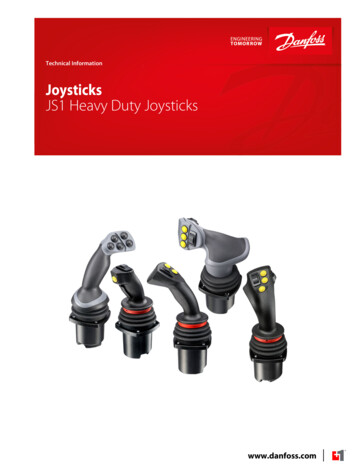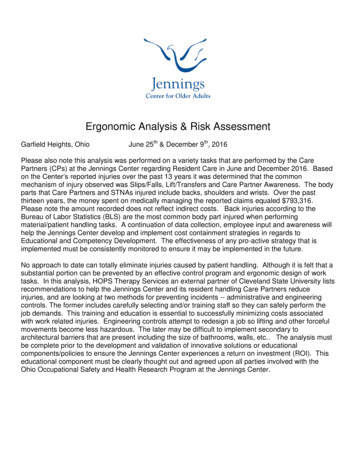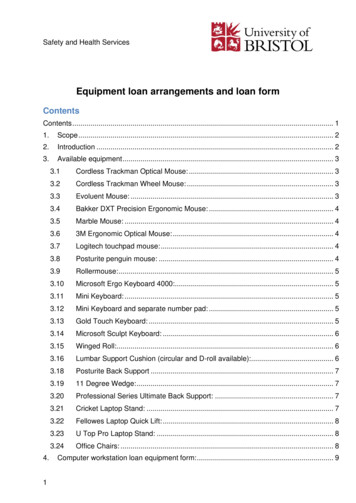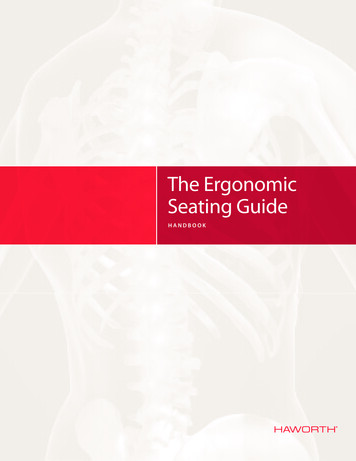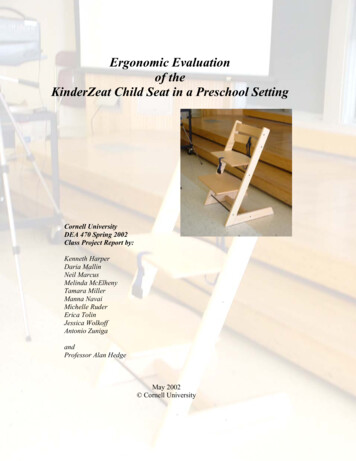
Transcription
Ergonomic Evaluationof theKinderZeat Child Seat in a Preschool SettingCornell UniversityDEA 470 Spring 2002Class Project Report by:Kenneth HarperDaria MallinNeil MarcusMelinda McElhenyTamara MillerManna NavaiMichelle RuderErica TolinJessica WolkoffAntonio ZunigaandProfessor Alan HedgeMay 2002 Cornell University1
INTRODUCTIONSeveral research studies have investigated the design requirements for children’s seating.Since children remain seated for long periods of time in school settings, many countries havepassed standards which assign school-age children suitable seating (e.g., Japanese StandardsAssociation cited in Hibaru and Watanbe, 1994). Some studies have shown that standards set bythe International Standardization for school furniture (ISO, 1979) appear to focus on the wrongdimensions of the child’s body when determining the appropriate chair size. Cho (1994)concluded that to improve seated posture and decrease discomfort in Korean children, lower leglength (from the knee down) should be used to determine optimal chair size. Another study doneby Hibaru and Watanbe (1994) showed that the Japanese standards for determining chair heightfor children, based on a calculation between child stature and upper leg (hip to knee) length,resulted in poor posture and increased complaints of lower back pain. Their findings agreed withCho’s, indicating that lower leg length is important in determining appropriate chair height forgood posture.Pre-school children are expected to sit about 30% of their time during school andteenagers, ages 13-18 years old, are expected to sit about 78% of their time. Sitting occupies alarge percentage of waking hours at an age when the human body is still in growth (Dillon,1976). Mandal (1985) noted the importance of furniture specifically designed for a child’s bodyproportions and recommended different sitting postures for different activities. He argued thatfor some activities an upright posture may be best, but added that it is unrealistic to expect of achild to sit in this way for extended periods of time, especially if the seat is set at an improperheight for the child. It is necessary for a seated child to be able to move and change their posturein order to reduce the onset of muscle fatigue, although a chair should not cause so muchpostural shifting that the child’s concentration is impaired (Laville, 1985).Research conducted on children’s posture in ergonomically designed chairs shows onlyminor improvement in favor of ergonomic seating as compared to ISO standard chairs(Troussior, 1999). Although increased perception of comfort and longer seating time wasrecorded for ergonomic chairs when compared to the ISO furniture, such improvements wereminimal if the ergonomic chair is not properly fitted to the child (Knight, 1999). It seems that2
ergonomic seating enhances posture and perceived comfort in long-term studies, though theresearch is limited to children who are aged five years and older.The need for specialized children’s seating has been recognized for centuries, yet nostudies have systematically investigated the effects of ergonomically designed seating on theposture and behavior of younger children (between the ages of three and four years). Pre-schoolchildren can sit in a variety of chair designs, but the advantages and disadvantages of differentstyles remains unexplored. Over the past 150 years there have been two recurrent styles ofchildren’s seating: the low chair, which is below the height of an ordinary chair, and the highchair, which raises a child above the seat height of a typical adult (Ollgaard, 2002). These twostyles are present in modern children’s seating, both in their original form and in new designs. Inaddition, two other recent designs have been developed to accommodate the seated youngerchild: the booster seat, and the KinderZeat. These four different design solutions for youngchildren’s’ seating are as follows:The low chair - is a scaled version of an adultchair intended to be used with other child-scaledfurniture. This type of furniture is commonly found inkindergartens and other preschool settings (Figure 1).The low chair allows the child to easily manipulate andinteract with their surroundings. In addition, a chairthat is low to the ground decreases the chance of aFigure 1 Example of low chairs sized forsevere injury if the child were to fall. Although thechildren (Source: Virco IQ -scale of the chair and furniture may help .between a child and his/her peers, it may inhibitchild/adult interaction. When to allocate different chairsizes to different sizes children is an issue with thesechairs.The high chair - raises a child above the normal adult seat height and is used by childrenfrom the age at which they can sit up on their own until they outgrow the chair, which istypically around the age of two (Figure 2). High chairs date back to 400 BC and are depicted in3
ancient Greek artwork. Today’s high chair typically contains a seat with a harnessing device,armrests that support a tray, and sometimes a footrest. High chairs can be built with plastic,wood, or metal frames and also contain fabric and other materials (O’Donnell, 2001).The main goal of a high chair is to allow achild to engage in activities around an adult-sizedtable, such as eating or playing games. This maypromote positive social interaction between childrenand adults. Recently, several high chairs have beenrecalled by manufacturers due to safety issues.These issues include lack of stability and harnessrelated security as well as the potential hazards ofloose parts. Ingress and egress often are beyond thechild’s control and an adult has to assist.Figure 2 Example of child’s high chair(Source: Moonpie Designs http://www.moonpiedesigns.com/prices.html)The booster seat – is a child’s seat that is made of either wood or a durable plastic.Normally the booster seat rests upon the seat panof an adult-sized chair and it may or may not beattached to that chair (Figure 3). The goal of thebooster seat is equivalent to that of the high chair:to involve the child in an activity at an adult-sizedtable. Drawbacks of the booster seat involve itsstability regardless of attachment to the base chair.Poor balance or improper fit may result in thechild, booster seat, or entire structure tipping over.Ingress and egress often are beyond the child’sFigure 3 Example of a child’s booster seat.(Source: Cambro Merchandising http://www.universalequipment.com/cambro mcontrol and can be difficult because of seaterchandising.htmstability, requiring that the child is lifted off thechair.The KinderZeat – is an innovative variation of traditional children’s seating (see Figure4). It combines the idea of a high chair with the idea of a low chair. It has a wooden frame with4
an adjustable height seat and independently adjustable height footrest. The adjustability of theKinderZeat allows it to accommodate a child from an age when they are able to sit up until theyoutgrow the chair (typically from around two through fifteen years old). The KinderZeat isproduced by Stokke Ltd., a Norwegian furniture company.According to the chair designer, PeterOpsvik, the KinderZeat’s goal is to lift thechild up to standard table height whilemaintaining support, balance, and movement.Guidelines for proper seating are in accordancewith the KinderZeat design:“Working with relaxed upper arms and elbowsat about ninety degrees provides comfort andhelps maintain straight wrists, which can bebeneficial The work surface should be at alevel that places the working height at elbowheight” (Sanders & McCormick, 1993).Figure 4 Example of the KinderZeat.(Source: Stokke Ltd. http://www.stokkeusa.com/)The KinderZeat designer’s claim is that the footrest is the key to maintaining this support,balance, and movement.“If children are seated in adult furniture, they lose contact with the floor. Thesolution was to create a chair, which moved the floor up to the children, insteadof the opposite approach. The footrest provides the child with the basic stabilityupon which movement is based” (Stokke Newsletter).Research conducted by Mandal (1981), Troussier (1999), and Knight (1999)supports the claim that the use of a footrest should improve the comfort and posture ofseated children who use it. Ingress and egress can more readily be under the child’scontrol in the KinderZeat.5
RESEARCH OBJECTIVESThe present study was conducted to test the claim that the KinderZeat’s footrest providesthe “basic stability upon which movement is based” and is essential in “alleviating strain andreducing ‘fidgeting”. To do this we devised a series of tasks to be performed by young preschoolchildren while sitting in the KinderZeat with the footrest, or without the footrest, a conditionequivalent to the child sitting in either and adult chair with or without a booster. Tasks weredevised to test the various reach capabilities and also the task persistence of young childrensitting in these test conditions. Specifically, the study tested whether:1. Use of the KinderZeat with footrest improves the maximum reach distance of youngchildren across a horizontal tabletop.2. Use of the KinderZeat with footrest improves the convenient reach distance of youngchildren across a horizontal tabletop.3. Use of the KinderZeat with footrest improves children’s task persistence at a boring taskperformed on a horizontal tabletop.4. Use of the KinderZeat with footrest improves the postural stability and reducesdistracting fidgeting in young children working at a horizontal tabletop. More fidgetingmay indicate greater discomfort and possibly greater postural strain.METHODSSubjectsAll subjects were between three and four years old, and were attending the CornellUniversity Early Childhood Program, located on the campus in Martha Van Rensselaer Hall,Cornell University. Children were selected based upon age, normal motor ability, and theirinterest in performing the required tasks. A total of 21 test trials was conducted with 19 children:two children were allowed to repeat the study at their request and 6 children chose not tocomplete both sets of experimental tasks. Consequently, complete data on both sets of trialswere available for 13 subjects. All subjects voluntarily participated in all aspects of this study.ExperimentersAll class members served as experimenters. All had successfully completed theUniversity’s Human Subjects training prior to conducting the study.6
ApparatusTwo KinderZeats were used: one with an adjustable footrest (see Figure 5) and onewithout the adjustable footrest, along with collapsible tables (33.5 inches square and 27.5 incheshigh). The height and depth of the chairs were set according to the age based settings specifiedin the manufacturer’s instructions sent with the chair. Two identical paintings of the solarsystem were made for use in the maximum reach task (see Figure 6). Two identical long boxeswith their tops decorated as ladders and with coin slots cut every half-inch (spanning a ladder 17inches long) were made for the convenient reach task (see Figure 7). Two identical boxes ofcolored pegs and several colored cups were used for the sorting task. All experimental sessionswere videotaped with identical VHS videocameras (Hitachi) each mounted on a tripod. All taskswere performed on the tabletops. All distances were measured with a tape measure. A checklistwas used to record subject’s fidgeting and postural stability during the sorting task.Figure 5 KinderZeatFigure 6 Solar SystemFigure 7 Box with slotswith footrest(Maximum Reach Task)(Convenient Reach Task)Experimental TasksSubjects performed the following tasks:1. Maximum seated reach task. Maximum reach is the farthest distance that can be reachedby extending the arm from the shoulder.7
2. Convenient seated reach task. Convenient reach is the farthest one can reach whilemaintaining the ability to manipulate an object while seated.3. Task persistence, postural stability and fidgeting. A simple sorting task was used tooccupy subject’s attention while their postural stability and fidgeting were recorded onprepared checklists. Colored pegs mixed in a large tub were manually sorted by colorinto each of 4 cups. The task was timed to measure task persistence.ProcedureTesting was conducted in the classrooms of the Cornell Early Childhood Program locatedin Martha Van Rensselaer Hall, Cornell University. Prior to any data collection, theexperimenters received instruction on how to work with young children from the Director of theCenter and visited the daycare center before beginning research to become familiar with thespace and materials that would be used. Experiments took place inside the classrooms duringdaycare hours. Experimenters worked in groups of 2-3 per test session. Children were recruitedby being asked if they wanted to play some games with the researchers. The games took placeamid the activities of other children, leading to more recruits and spectators, but not halting theactivities in the preschool.At the beginning of each session, the distance between the KinderZeat and the tabletopwas measured by asking the child to stand up on the footrest while an experimenter moved thetable towards the child until it slightly touched their thighs. The location of the chair and tablewas marked by placing a piece of masking tape on the floor in front of the chair and table legsfor later reference. The two KinderZeats (with foot rest and without footrest) were alternated asstarting chairs for each child. A video camera was placed on a tripod close to the chair and tablesuch that the entire seated child was captured from a right-hand side profile. Taping began as thechild entered the chair.The entire experiment consisted of three separate “games.” The rocket ship game testedfor maximum reach. The coin slot game tested for convenient reach. The sorting task that wasused tested for task persistence, postural stability and fidgeting. These “games” were alwaysadministered in the same order in each test condition. Once seated, the child was asked if theywould like to play the first game. If they said “yes”, then the maximum reach task wasperformed. If they responded “no”, the experimenter continued speaking with the child until s/hefelt comfortable enough to continue or decided to withdraw from the experiment.8
For the maximum reach task the painting of the solar system was placed flat on the tablewith the edge matching up with the edge of the table closest to the child. A tape measure wascentrally placed on top of the painting, such that 0 inches was flush with the edge of the tableclosest to the child. The child was asked to place one hand over the other (middle fingers linedup) and then asked to pretend that his/her hands were a “rocket ship.” S/he was then asked toreach out as far as s/he could along the tape measure three times. The distance from the startingline (the edge of the table) to the tip of his/her middle fingers was recorded. Note: it was mostdesirable that the child remained seated in order to get an accurate reach distance, however,many children propped themselves up in order to reach farther.The child’s convenient reach zone was measured by placing the front edge of the coinslot box (with a maximum possible convenient reach of 17 inches) at the point of the child’smaximum reach distance. The child was asked to insert coins in every slot, beginning from theone closest to them and ending with the farthest one they could comfortably reach. The numberof the last hole was recorded. The task was performed three times.Task persistence, postural stability and fidgeting were measured by timing and observingperformance on a color sorting task. The task was intentionally designed to be tedious, but notdaunting, to see how long children would perform a task and how much they fidgeted. A bin ofcolored pegs (four different colors) was set out before the child along with corresponding coloredcups. The child was asked to place each peg into its corresponding colored cup (red pegs in redcups, green pegs in green cups, etc.). A three- minute time limit was imposed. Any indicators ofpostural discomfort, fatigue, adjustment, restlessness, or fidgeting were recorded on a preparedchecklist. Additionally, the length of time the child worked on the task uninterrupted wasrecorded, as was the number of times the child asked when the task was going to be over.The child’s dismount off of the KinderZeat and entrance onto the next KinderZeat wasvideotaped. The entire procedure was repeated again using the alternate chair. The distancefrom the table to the second chair was held constant by the use of the masking tape markspreviously laid out on the floor to implement the placement of the chair.After all three tasks were completed in both seats (KinderZeat with footrest andKinderZeat without footrest), the experimenter(s) thanked the child for a marvelous job,acknowledging that s/he has helped tremendously. The experimental arrangement was reset forthe next subject. See Appendix A for a more detailed outline of the test procedure.9
Data AnalysisAll distance data, measured in inches, and counts of fidgeting and of postural stabilityindicators were entered into a computer and analyzed in the Statistical Package for the SocialSciences (SPSS v.11). Differences between the two test conditions: with footrest (F) and withoutfootrest (NF), were tested. For the maximum reach task two measures were tested: the averagevalues of the 3 maximum reach distances per child per condition, and the maximum value of themaximum reach distance per child per condition. For the distance measures this testing wasdone using paired sample t-tests. For the counts of fidgeting and stabilization movements thiswas done using a Wilcoxon Matched Pairs signed ranks test.RESULTSMaximum Reach DistanceThere was a significant difference (t 2.681, df 12, p .020) in the average of themaximum reach distances for the three trials between the two conditions (see Figure 8). For seatF this distance was 25.3 0.8 inches and for seat NF it was 21.5 1.4 inches. Using only thegreatest reach values for each child, the difference between conditions remained significant (t 2.314, df 12, p .03), and the average of these maximum reach distances for seat F was 26.9 1.0 inches and the mean distance for seat NF was 21.5 1.8 inches.Convenient Reach DistanceThere was no significant difference for either the average or maximum convenient reachdistances between the two seating conditions. For the average of the three convenient reachdistance trials per child, the mean distance for both seat F and for seat NF was 16.4 2.4 inches.For the maximum of any convenient reach distance per child the mean distance for seat F was176 1.7 inches and the mean distance for seat NF was 16.1 0.9 inches.10
3025Distance (inches)20151050Mean MRFMean MRNFMaximum MRFMaximum MRNFFigure 8 Distance vs. Seat Condition for Maximum, Maximum Reach and Mean MaximumReach (MRF – Maximum Reach with Footrest; MRNF - Maximum Reach without Footrest)Task Persistence, Fidgeting and StabilityThere was no significant difference for task persistence measures between the twogroups. The mean duration on task performance for seat F was 108.0 21.9 seconds and for seatNF this was 116.7 22.5 seconds.Initially, a count of each subject’s total distracted behaviors was used to determinewhether or not this was influenced by the presence of a footrest (see Table 1). The videotapeswere also reviewed to obtain a count of the physical movements made by the subjects in eachtest condition. Upon analysis it was noted that many of the movements constituted bodystabilization movements rather than fidgeting. As a result, fidgeting and stabilization movementswere analyzed separately. The Wilcoxon test showed a statistically significant differencebetween the the seat F and NF conditions for the number of fidgeting movements (Z -2.719, p 0.007) and the number of stabilizing body movements (Z -2.680, p 0.007: see Figure 9).11
Footrest89Nofootrest1044202Change in physical positionto ways that will not benefitperformance717Stopping task prematurely22Turns head away from taskEyes wander around roomInquires about stopping,moving, or doing somethingelseVerbal complaint (negativestatement about task orpersonal physical state)Table 1 Total number of distracted behaviors observed in each test condition.65Count43210Fidget FFidget NFStability FStability NFFigure 9 Number of fidgeting and body stabilization movements for each seat condition12
DISCUSSIONThis study found a significant effect of using the KinderZeat footrest on the young child’smaximum reach distance. The presence of the footrest allowed children to both squat and stand,helping them reach further on the table. For the average maximum reach distances for 3-4 yearsold children the use of the footrest added 3.8 inches to the reach distance and for their greatestmaximum reach the use of the footrest added 5.4 inches to this distance. Children could reachfurther with the footrest present, probably because it helped provide additional support andstability. When no footrest was present children had no obvious place for their feet to rest andwere unable to reach as far on the test table. The reduction in maximum reach probably occursbecause of the difficulty of stabilizing the body with unsupported feet.The presence of the footrest did not significantly influence the average and maximumconvenient reach distances as measured by the coin slot game. Since the children were sittingdown to perform this convenient reach task, they did not need to use to the footrest to help themreach further. Also, some problems in the data collection phase might have affected theseresults. It was difficult to explain to the young children that the goal of the game was to put thepenny coin in the farthest slot, and many children were content with just putting the penny in anyslot. Sometimes, it was difficult to measure the exact distance of the slot from the edge of thetable, as the box had to be moved between trials. Additional convenient reach studies should beconducted to ensure there is no relationship between the different chair conditions andconvenient reach tasks.The task persistence data showed no statistically significant difference between thefootrest and no footrest conditions. Children did not spend any more time pursuing the sortingtask in either condition. Many confounding variables may have been present in this portion ofthe study that could have influenced this result. Children were asked to perform the task twice,and they might have become bored or fatigued the second time around. Although the order oftesting of the chairs was counterbalanced, many children ended the task early the second timearound, which indicates a possible practice effect with the sorting task. Further studies of taskpersistence should be conducted to evaluate possible differences between the footrest and nofootrest conditions.13
The results from the fidgeting data show a statistically significant difference between thetwo chair conditions, indicating that fidgeting was much more common in the no footrestcondition. The footrest was used to provide additional support by the children, which resulted inless overall fidgets and movements. When children sat in the chair with no footrest, they seemedto move more because they had less support for their body, resulting in fidgeting as they tried toget comfortable while performing the task. The body stabilization results between the twoconditions also showed a statistically significant difference. Children moved more in the nofootrest condition because they were trying to stabilize their lower bodies by wrapping their feetaround the chair legs or trying to use the small cross bar beneath the seat, whereas in thecondition with the footrest they had a place to rest their feet.The results of this study clearly show the importance of good foot support for the seatedchild. The differences found resulted from comparing the same chair design with or without thefootrest. However, one problem with the no footrest condition tested is that children tried to findsomething else to stabilize their bodies and with this chair design they succeeded, and this wouldnot be true had they been sitting in a booster seat. In the no footrest condition many childrenwere able to use the reinforcement bar at the bottom of the chair to stand on to help themperform the tasks, which helped to improve their maximum reach performance. Children alsoused the reinforcement bar beneath the seat to stabilize themselves. In the footrest conditionsome children stood on this to complete the reach tasks. Finally, the classroom environments inwhich the testing occurred proved to be very distracting to the young children, possibly affectingthey responded to the various tasks.In conclusion, this study shows that the KinderZeat with its footrest does help improvethe young child’s maximum reach distance, their body stability when seated and also reduces theamount of fidgeting. In this testing it did not influence the convenient reach distances or taskpersistence. Additional research is needed to investigate the how body postures are influencedby the KinderZeat for children performing a range of activities. It would also be interesting totest children at different ages, to see what results the footrest and no footrest would have onvarious age levels. The research conducted thus far has shown that the KinderZeat with afootrest does help improve children’s functioning while sitting, and it opens doors for futureexploration in these concepts of ergonomic seating for children.14
APPENDIX A: DETAILED PROCEDURES1. Set up one KinderZeat and one table, out of direct eyesight of the rest of the waiting subjectswhere possible. Have the second KinderZeat nearby. The two seats should be adjusted tothe same height and depth, however one of the KinderZeats should have a footrest and theother should not.2. Affix the Maximum Reach posters to the tables with tape, aligning the zero line with theedge of the table facing the chair. Make ready the data sheets, Fidgeting Checklists, pen,blocks, cups, slot box and coins.3. Place a camera at each station such that the participants are recorded in profile, fromapproximately elbow height when seated, and at a zoom percentage that captures the entirechild’s body and movements yet retains detail.4. The experimenter welcomes the child into the area, introducing him or herself. Invite thechild to join you at the table to play some games. The recorder writes comments on thechild’s approach and entry of the chair.5. Ask the child to stand on the footrest, and slide the table up to the child’s body. Then ask thechild to sit.6. Mark the floor with tape where the legs of the table are located and the back of theKinderZeat’s legs are located. (NOTE: for every other child, begin with no footrest instead offootrest.)7. Begin the maximum reach task: ask the child to pretend his or her hands are a rocket ship,and to reach out with both hands as far as he or she can, straight out. At the furthest reach ofthe child’s hands, make a mark and write the child’s initials next to it. Record the distancefrom the starting line (the edge of the table) to the mark AND THE UNITS OF YOURMEASUREMENT. Note: it is desirable that the child remains seated; if he or she stoops orstands, disregard the measurement and ask him or her to repeat the reach. Repeat this taskfor a total of 3 measurements, having the same person read the measurements each time.8. Next, the Convenient Reach activity: place the box in front of the child such that the last slotis at his or her furthest Max Reach mark and the row of holes proceeds toward the child. Askthe child to put the coins into the holes in the box, starting with the closest one and working15
his or her way outward. Record the number of the last hole the child could effectively reach.Repeat for a total of 3 trials.9. Then the Task Persistence observation: replace the box and coins with a bin of mixed coloreditems and four cups (red, yellow, green and blue). Ask the child to sort the items into thecups by color. This bin of colored items should be sufficiently large such that the child willnot be able to sort all of the items in a three-minute period. Observe the child while he or sheis sorting, and record any indicators of discomfort, fatigue, restlessness, or fidgeting as perthe Fidgeting Checklist. Also record the amount of time the child continues working on thetask uninterrupted. If he or she works the entire three minutes, stop the child and recordthree minutes. At the two minute mark, tell the child that he or she will have to stop soon, toplay a different game.10. Ask the child to dismount the KinderZeat and replace it with the other KinderZeat. Makesure the chair and tables are put back in the same place as before, according to your tapemarks on the floor.11. Reset the props for the maximum reach activity and repeat as above, so that each childperforms all 3 tasks in a seat with a footrest and a seat without a footrest. Record data for thesecond round on the appropriate data sheet, making sure that the measurements are recordedon the same numbered line and with the same initials as the first sheet.12. The experimenter should then thank the child for playing, and direct him or her back to theclassroom. Record the child’s dismount of the KinderZeat.13.When all of the data have been collected, stop the video cameras and save the grid papers.Put away all the supplies in their proper places (or in the designated spot for the next groupof experimenters).14.Report any troubles with the experiment or important findings to the other members of theclass so that they may have enough time to make changes as necess
Normally the booster seat rests upon the seat pan of an adult-sized chair and it may or may not be attached to that chair (Figure 3). The goal of the booster seat is equivalent to that of the high chair: to involve the child in an activity at an adult-sized table. Drawbacks of the booster seat involve its



